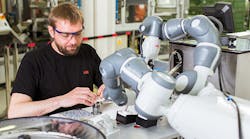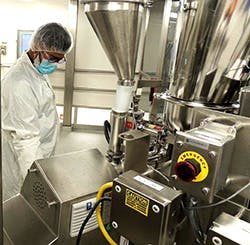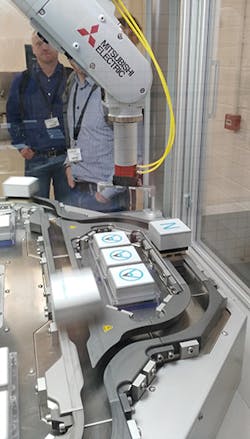The Internet of Things (IoT) has been widely celebrated as a game-changing technology for field service and maintenance applications because it allows one device to “talk” to another, communicating when a machine or system could potentially degrade or fail. But what if the “breakdown” is occurring not within a facility or a production process, but within the human body?
That’s exactly the type of IoT application that healthcare products giant Johnson & Johnson is investing in. In fact, the $70 billion, 130-year old manufacturer is in the process of reinventing itself, via an annual spend of $2 billion in technology.
“We see ourselves not only as a healthcare company but also as a technology company because technology is dramatically changing the landscape of what’s possible for us,” says Kathy Wengel, J&J’s chief supply chain officer. “We approach problems of global health through Big Data and analytics to look at patient populations in different ways, we design smart products and we use technology on an ongoing basis to improve the patient or the customer outcome. And we’re using technology internally as well, in how we run our manufacturing plants and in how we do business.”
At a recent investor meeting, Sandi Peterson, J&J’s executive vice president and group worldwide chairman, outlined the company’s enterprise health technology strategy:
• Build a flexible, secure digital business that uses technology to streamline J&J’s core business, build enterprise capabilities and reduce the company’s development cycles.
• Develop smart products that learn by taking in data, analyzing it and adapting it to business needs based on insights from consumers, patients and providers.
• Create new models of engagement to improve experience and outcomes.
And while IoT investments are not segmented as its own category at J&J, sensor-based technology is having a huge impact on how J&J makes its products as well as on how those products might interact with patients—even, yes, from inside the patient.
Enabling the Shift from Batch to Continuous Manufacturing
J&J has 250,000 customers, who account for roughly 100,000 orders per day on a globally balanced scale. The company’s supply chain team, led by Wengel, is responsible for working with J&J’s R&D department to bring to life every product the company makes around the world—more than 300,000 SKUs—and to make those, test those and deliver those to customers worldwide. Over the past year, the supply chain team’s innovation strategy has become much more technology-focused. “Our strategies aren’t just based on where we put our plants or optimizing our logistics networks,” Wengel says, “but are now built around how technology will help change our innovation strategy.”
One of the key areas where IoT is having an impact at J&J is within its pharmaceutical business. For decades, J&J has produced its tablets and pills through a multi-stage batch process. “After each step we stop, take samples, send them to a laboratory in the plant, wait for the results, and then proceed to the next step,” Wengel explains, noting that the basic process has changed very little over the years.
However, thanks to its adoption of IoT technologies, J&J is the first pharma company to win approval from the FDA to shift a product— Prezista, an HIV medication—from batch to continuous manufacturing. That shift is enabled by in-line sensor technology that allows the company to eliminate the separate testing and sampling steps.
“We’ll be able to put raw materials in at one end and through the steps of mixing, blending and compressing the materials into tablets, through sensor technology that’s embedded in the equipment, we’ll be able to perform the testing online, in real-time,” she says. “Our use of IoT-enabled continuous manufacturing opens up a much greater world of flexibility, a dramatic reduction in cycle time, and allows us to use our people resources more efficiently.”
Vision for the Future
In J&J’s vision care business, work is underway on the development of self-correcting contact lenses and other lens platforms that can provide real-time data on the health of a patient’s eyes. The company is also using IoT technology to produce contact lenses using one-third the manufacturing space at twice the rate as previously.
The company is also partnering with HP to apply 3-D printing technologies to healthcare in such areas as eye health, orthopedics and consumer products. “Combined with advances in data mining and software, 3-D printing could enable distributed manufacturing models and patient-specific products, therapies and solutions that deliver better outcomes, better economics and improved global accessibility,” Peterson observes.
Other uses of technology include collaborative robots, which enable complete mimicking of human articulation, allowing collaboration with a human. These robots are being used, for instance, in the support of consumer product manufacturing. J&J also has a joint venture with Verily, Google Alphabet’s Alphabet Inc.'s research organization devoted to the study of life sciences. The two companies are developing a new generation of surgical robots that would integrate medical device technology with robotic systems, imaging and data analytics. The goal of robotics-assisted surgery is to provide surgeons with greater control, access and accuracy during surgical procedures, thereby minimizing patient trauma and scarring while accelerating post-surgical recovery.
On the medical devices front, J&J is exploring the idea of implanting sensors into artificial joints, such as knees or hips, to monitor the range of motion a patient has from the joint while in physical therapy. The success of a joint implant surgery, Wengel notes, comes not just from the procedure itself, but from the preparation before the surgery as well as the rehabilitation afterwards. So the IoT can not only provide data on production machinery but on devices carried within a human being as well.
When it comes to J&J’s customer-focused technology, it’s important that the company is able to track and trace products throughout its extended supply chain as they get handed downstream from manufacturing to a distributor or to a customer. IoT allows J&J to gather data—whether it’s scanned at the patient level in a hospital or on a truck in transit to its end destination, and now even at the beginning of the raw material stage when might literally be coming out of the ground—to provide a high level of assurance.
For instance, much of J&J’s vaccine portfolio requires the medicines be transported in frozen conditions, even when the products are being shipped into sub-Saharan Africa. The ability to have temperature sensors and monitors that are embedded with the product, transmitting real-time signals to assure that the product is maintained at those temperatures, is an example where IoT technologies provide significant human health value by connecting J&J’s healthcare supply chain through real-time data, Wengel points out.
“At the end of the day,” she adds, “we’re in the business of healthcare and that comes with a very special set of responsibilities because people need healthcare at very vulnerable times in their lives. You can’t just talk about the IoT without understanding the ecosystem that you’re trying to connect a device to: What is the business question and what is the health question you’re trying to solve with IoT? Therefore, while there’s a lot of cool technology out there, when we introduce a technology into the healthcare value chain, we have to be able to assure that it will repeatably and correctly do what it purports to do.
As Wengel explains, “IoT gives us the ability to make decisions on real-time data in an industry that has often used separate testing that happens over days or weeks, feedback that you’d get customers on a monthly basis. This is a very different world, and IoT is absolutely changing the pace of how we run our supply chains.”







